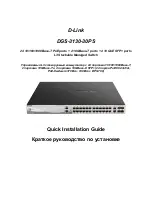
DGS-3224TGR Gigabit Ethernet Switch User’s Guide
16
802.1d/802.1w Compatibility
RSTP can interoperate with legacy equipment and is capable of automatically adjusting BPDU packets to 802.1d format
when necessary. However, any segment using 802.1 STP will not benefit from the rapid transition and rapid topology
change detection of RSTP. The protocol also provides for a variable used for migration in the event that legacy equipment
on a segment is updated to use RSTP.
The Spanning Tree Protocol (STP) operates on two levels: on the switch level, the settings are globally implemented. On
the port level, the settings are implemented on a user-defined Group of ports basis.
VLANs
A Virtual Local Area Network (VLAN) is a network topology configured according to a logical scheme rather than the
physical layout. VLANs can be used to combine any collection of LAN segments into an autonomous user group that
appears as a single LAN. VLANs also logically segment the network into different broadcast domains so that packets are
forwarded only between ports within the VLAN. Typically, a VLAN corresponds to a particular subnet, although not
necessarily.
VLANs can enhance performance by conserving bandwidth, and improve security by limiting traffic to specific domains.
A VLAN is a collection of end nodes grouped by logic instead of physical location. End nodes that frequently communicate
with each other are assigned to the same VLAN, regardless of where they are physically on the network. Logically, a
VLAN can be equated to a broadcast domain, because broadcast packets are forwarded to only members of the VLAN on
which the broadcast was initiated.
Note: VLANs on the DGS-3224TGR
No matter what basis is used to uniquely identify end nodes and assign
these nodes VLAN membership, packets
cannot
cross VLANs without a
network device performing a routing function between the VLANs.
The DGS-3224TGR supports only IEEE 802.1Q VLANs. The port
untagging function can be used to remove the 802.1Q tag from packet
headers to maintain compatibility with devices that are tag-unaware.
The switch’s default is to assign all ports to a single 802.1Q VLAN named
“default.”
The default VLAN has a VID = 1
IEEE 802.1Q VLANs
Some relevant terms:
•
Tagging
– The act of putting 802.1Q VLAN information into the header of a packet.
•
Untagging
– The act of stripping 802.1Q VLAN information out of the packet header.
•
Ingress port
– A port on a switch where packets are flowing into the switch and VLAN decisions must be
made.
•
Egress port
– A port on a switch where packets are flowing out of the switch, either to another switch or to an
end station, and tagging decisions must be made.
IEEE 802.1Q (tagged) VLANs are implemented on the DGS-3224TGR 802.1Q VLANs require tagging, which enables
them to span the entire network (assuming all switches on the network are IEEE 802.1Q-compliant).
VLANs allow a network to be segmented in order to reduce the size of broadcast domains. All packets entering a VLAN
will only be forwarded to the stations (over IEEE 802.1Q enabled switches) that are members of that VLAN, and this
includes broadcast, multicast and unicast packets from unknown sources.
VLANs can also provide a level of security to your network. IEEE 802.1Q VLANs will only deliver packets between
stations that are members of the VLAN.
Содержание DGS-3224TGR - Switch
Страница 1: ...D Link DGS 3224TGR Managed 24 Port Gigabit Ethernet Switch User s Guide...
Страница 41: ...DGS 3224TGR Gigabit Ethernet Switch User s Guide 29...
Страница 160: ......
















































